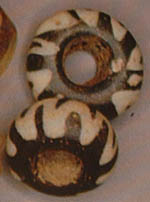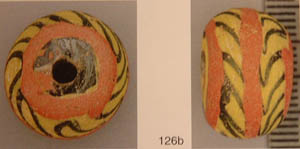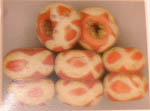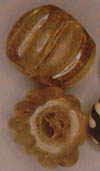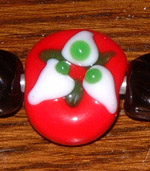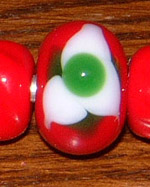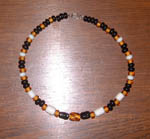Weaving
Costumes
Embroidery
Medieval Games
Eve's Beads
In March of 2005 I was bitten with a new creative bug when a friend introduced me to lampwork. This is where I'm putting most of my creative energy lately, when my workshop isn't being used as a junk room at least.
I try to base most of my work off of images of extant beads. Sometimes I aim for accuracy in colour and form, other times I let myself be creative in one or both of these things, while maintaining only a norse "flavour". Rarely, I will experiment with purely modern styles.
My favourite resource is Glass Beads from Early Anglo-Saxon Graves by Birte Brugmann. I can't say enough good things about this book. I will admit though, in my impatience to just start creating, I skipped the text and went straight for the pictures and I still haven't made it back to reading it yet. I like this book because the images included are actual photographs of the beads.
Another great resource is Trade Beads and Bead Trade in Scandinavia ca. 800-1000 A.D. by Johan Callmer. As far as I know, this one is out of print, but you may get lucky and find it somewhere or you can Inter-Library-Loan it and photocopy the whole lot like I did. I know that is against copyright law in most places, but it is specifically allowed here in Canada (as long as the copy made is for personal use only). That said, it is not supporting the author, but I figure I would buy it if I could, and as with previous books where I've taken this approach (Peter Collingwood's Techniques of Tablet Weaving), if the publisher re-publishes it I will buy the original, so I don't feel guilty. Make sure you splurge and get the colour plates photocopied in colour. I like this book because of the wealth of information in the plates. All plates are unfortunately drawings of the beads (not photos), but the sheer number of beads included makes it an invaluable resource.
I started working on a friend's torch in March of 2005 and within a month, went out and purchased my own. I'm working on a simple, inexpensive Hot Head torch with MAP gas. I rarely use Bullseye glass, preferring the range of colours available in Moretti. I did try mixing them once with disastrous results, so it's really true, pick one or the other. I cool my beads in Vermiculite, at first just in a plant pot, later I put it in a crock pot to keep it heated. I have my beads annealed in batch lots at a local store (inexpensive and does the job).
2005
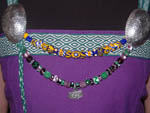 My festoons |
My first "set" of decent beads was completed from March to April of 2005. Purple, green and white are my heraldic colours and I had made a Norse apron dress using those colours. This strand represents most of my early work and I was far less picky than I would later become when selecting which beads were "good enough". The colour is entirely non-period. Some of the designs are very period, others are quite modern. I was doing a lot of experimenting and had to use most of the beads I'd made to get a long enough festoon in time to wear it to something. The brooches and Thor's Hammer are from Fettered Cock Pewters. Above the purple and green set, you can see the blue and yellow set I completed later. Much larger and fancier beads there, but also did not wear as well as the lower set. While none of the beads have cracked, some of the tiny spots on the centre focal bead have popped off. This set is also more further out on the "creative" scale, with most of the forms being non-documentable. This set was completed in two days in September of 2005. |
|||
 Jolly Procrastinator's beads |
This was the first set I completed for gifting. My friends back home started a household and included me as a founding member, despite the distance I'd moved away. I was going through an authenticity kick (as were most of them) and decided we needed favours that were more suitably period. I came up with beads. I made a set of beads, each bead incorporating all of the household colours (yellow, white, purple and black) and with no two beads being the same, though many motifs were shared. I figured that was a good way to represent us; all made of the same stuff but each unique. I made one bead for each member and a spare so everyone would have at least some choice. As you can see, I'm already improving my skills over my first set. |
|||
 Pelican Beads Pelican Beads
|
In May of 2005 I heard that a friend of mine back home earned her pelican and this seemed like the most appropriate gift I could come up with to congratulate her. I gave them to her at Pennsic. They are supposed to be blood drops on a white backdrop, which is one of the symbols of that order. My husband thinks it looks like blood on marshmallows. |
|||
 Laurel design beads |
The same day in May as I completed the set above, I also made some beads for myself with this laurel-leaf style pattern. These are currently on a modern necklace with an antique key. In case anyone wants to know, this pattern is made by running horizontal lines of stringer across the bead, melting it in and then dragging a probe through the bead vertically all the way around. Melt it smooth and voila, leaves! |
|||
 Pennsic Laurel Prize Tourney beads |
These beads were made in May, but the set was completed on-site as my entry into the Laurel's Prize Tourney at Pennsic 2005. Unfortunately, I do not have a picture of the final completed set, just these first few beads. I did not provide documentation (no photocopier on site) and I did not string them, choosing to leave that up to the new owner. As a result, mine was one of the last prizes chosen. If you give beads away string them, people seem to like that better. The "documantation" images are taken from Brugmann's book. The shape of the spotted beads is a little off (should be a bicone) and also my zig zags should be smaller and tighter.
|
|||
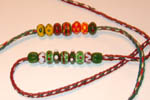 Gifts for the royals |
Sets of beads for the Queen of An Tir (yellow, green and red) and the Princess of Avacal (green, white and maroon), given at the June Coronet. The Queen's beads were made first and I cracked the focal in half while cooling. Not one to be defeated so easily, I crazy glued it together. I never did meet the Queen, nor do I know if the bead held together. I would not take this approach in the future, but it was my best bead to date and I couldn't bring myself to throw it out even if it was broken. The Princess' beads were made next and my skills improved. I like this set much better. Both sets are strung on fingerloop braiding in a barley corn pattern in simple crochet cotton, in colours complimenting the beads. I do not know how well this sort of stringing is received as I am never there when the actual gifts are given. Documentation for both sets is again from Brugmann's book. I used the spot and zig zag documentation above (and I think got a much closer adherence to the source material this time) and added the figure-8, melon and focal bead documentation below:
|
|||
 Lost Viking beads |
I started on this set concurrently with the first festoon I made for myself. This set was my graduation gift to the head of my household when I graduated from thralldom in the Lost Vikings. It was given to Wernar at Avacal Inland War before I went to Pennsic. I believe he decided it should be worn by our most worthy fighter at the next Quad War, so I don't know where it is now. It is made entirely of colours from our household arms, and with the low contrast between red and black that was quite a challenge. Those two colours are nearly indistinguishable when heated, and not much better when cooled. As there were 50 members of the household at the time, I made 50 beads and then some, and strung then on a matching fingerloop braided cord. Obviously not all of the beads are pictured here. Some were finished on-site at Avacal-Inlands War. Some day I hope to get a picture of the whole set. As with my first festoon, because this was an early set and a set for which I needed a large number of beads, I allowed some into the set that I would currently probably set aside and replace. |
|||
 Heraldic beads |
In September of 2005, newly returned from Pennsic where I learned many things from both classes and the people I camped with, I was inspired to try my hand at some totally modern beads with possible SCA use. I experimented with the heraldry of my old kingdom, Ealdormere as I was not about to try the lion or griffon of AnTir or Avacal. I think they turned out well, though I have neither used nor gifted them yet.
|
|||
 The bead line up, by size, prior to stringing |
In November I got the idea of making myself a fake bone, amber and jet necklace. These materials were all popular with the Norse, but all either out of my price range or yummy and tempting to my pets. I decided to try to make myself a necklace I could wear that would be useful both in and out of the SCA. I still wear this necklace as day-to-day jewelry. There are 69 beads in this set, which I lined up prior to stringing in order to get the "larger" ones near the middle and the "smaller" ones at the end. 65 of these beads were completed in a single session, which is probably why I was able to be so consistent. It is very interesting how many beads are required to make even the smallest necklace. |
2006
 Wernar's largesse |
In August of 2006, Wernar and Tatiana stepped up to the thrones of Avacal. I presented these beads to be given as largesse. Beads which are given as largesse do not need to match as likely no one will ever get more than one bead anyway, so these "sets" are a bit of a mixed bag of whatever I had lying around that wasn't completely embarrassing. Starting from the top left and going clockwise, we have beads in the colours of Avacal. Originally intended as a set but I got tired of red, yellow and white rather quickly. The first bead is an attempt at a recreation of a double bead in Brugmann's book, but unfortunately I made the figure-8s different on the two halves. The next two beads are recreations of beads I've seen but cannot remember where. Instead of dragging a probe I have dragged the edge of a butter knife. This means that you get a zig zag effect rather than the lines melting and merging. Then we have some white, blue and red figure-8 spot beads that are true recreations of some beads in Brugmann's book and some white spacers to go with them. More Avacal themed beads, including the yellow and white chequey that worked quite well and the amber and white which did not. The amber didn't make the sharp corners that the yellow was able to achieve, so it looked more blobby. Next is a bead that was left over from my blue, yellow and white festoon. The blue and white spirals are recreations of some beads in Brugmann's book. Some ice-blue beads inspired by things I saw at Pennsic in 2005. My first attempt at mille fiori stringers, which taught me a lot. In order to keep the definition of the shape, you have to press it in with a marver as you melt it, otherwise it will tend to flop over and lose definition. The last three are failed experiments that were not good enough for some of my other sets, but which are not failed beads. |

